Temperature Distribution in Asphalt Concrete Layers: Impact of Thickness and Cement-Treated Bases with Different Aggregate Sizes and Crumb Rubber
Abstract
:1. Introduction
2. Data Collection from Numerical Simulations
- The pavement surface temperature (Tsuf) was obtained from actual field measurements every 10 min from the field monitoring from 28 June to 2 July 2021, as reported by Tran et al. [18];
- One-way heat transfer in the vertical direction was applied. Thus, the surrounding boundary was insulated;
- A 2 m depth was considered adiabatic due to the roadbed temperature being relatively stable during a monitoring period [39];
3. Effect of CSB on Temperature Distribution in Variable-Thickness AC Layer
3.1. Effect of Graded Aggregates Gradation of CSB
3.2. Effect of RA Contents in Rubberized CSB on Temperature Distribution in AC
4. Model Development ANN for Temperature Distribution Prediction in AC
4.1. Correlation Analysis of Variables
4.2. Development of ANN Model
4.3. Temperature Prediction Comparison between ANN and Numerical Simulations
- (i)
- Selecting appropriate AC properties for pavement analysis and design;
- (ii)
- Estimating the depth AC temperature used to test the modulus of elasticity of semi-rigid pavements using the falling weight deflectometer test;
- (iii)
- Finding a way to reduce temperature distribution in summer seasons;
- (iv)
- Analyzing the long-term performance of pavements.
5. Conclusions
- CSB gradation influences temperature distributions in semi-rigid pavement structures. CSB Dmax 31.5, with a higher density than CSB Dmax 25, resulted in lower temperature fluctuations at the bottom of the AC, of around 8%. It also led to negligible temperature variations between the AC top and bottom, of less than 5.5%;
- Incorporating RA in CSB Dmax 25 reduced the temperature distribution within the AC. Primarily, a 5% addition of RA resulted in up to a 20.4% reduction in temperature fluctuation at the AC bottom. A slight increase in the temperature difference between the top and bottom of the AC was observed when RA was used; however, these changes were insignificant for semi-rigid pavement structures with an hAC exceeding 12 cm;
- The proposed ANN model with four inputs, including the time of day, pavement surface temperature, AC thickness, and depth, was adopted to predict the temperature in the AC of semi-rigid pavements, was confirmed by the Ansys-based numerical simulations. This model was applied in free-rain conditions with a pavement surface temperature range of 32.4 °C ÷ 66.1 °C and an AC thickness varying from 6 cm to 26 cm. The proposed model, confirmed by the numerical simulations, exhibited high accuracy (R2 = 0.996 and MSE = 0.000685).
Author Contributions
Funding
Data Availability Statement
Acknowledgments
Conflicts of Interest
References
- Xuan, D.X.; Molenaar, A.A.A.; Houben, L.J.M. Shrinkage Cracking of Cement Treated Demolition Waste as a Road Base. Mater. Struct. Constr. 2016, 49, 631–640. [Google Scholar] [CrossRef]
- Mohammadinia, A.; Arulrajah, A.; Sanjayan, J.; Disfani, M.M.; Win Bo, M.; Darmawan, S. Stabilization of Demolition Materials for Pavement Base/Subbase Applications Using Fly Ash and Slag Geopolymers: Laboratory Investigation. J. Mater. Civ. Eng. 2016, 28, 04016033. [Google Scholar] [CrossRef]
- Gnanendran, C.T.; Paul, D.K. Fatigue Characterization of Lightly Cementitiously Stabilized Granular Base Materials Using Flexural Testing. J. Mater. Civ. Eng. 2016, 28, 04016086. [Google Scholar] [CrossRef]
- Mráz, V.; Valentin, J.; Suda, J.; Kopecký, L. Experimental Assessment of Fly-Ash Stabilized and Recycled Mixes. J. Test. Eval. 2015, 43, 264–278. [Google Scholar] [CrossRef]
- Lv, S.; Xia, C.; Liu, H.; You, L.; Qu, F.; Zhong, W.; Yang, Y.; Washko, S. Strength and Fatigue Performance for Cement-Treated Aggregate Base Materials. Int. J. Pavement Eng. 2019, 22, 690–699. [Google Scholar] [CrossRef]
- Adaska, W.S.; Luhr, D.R. Control of Reflective Cracking in Cement Stabilized Pavements. In Proceedings of the 5th International RILEM Conference, Limoges, France, 5 May 2004; Volume 2, pp. 1–8. [Google Scholar]
- Farhan, A.H.; Dawson, A.R.; Thom, N.H.; Adam, S.; Smith, M.J. Flexural Characteristics of Rubberized Cement-Stabilized Crushed Aggregate for Pavement Structure. Mater. Des. 2015, 88, 897–905. [Google Scholar] [CrossRef]
- Liu, L.; Wang, C.; Liang, Q.; Chen, F.; Zhou, X. A State-of-the-Art Review of Rubber Modified Cement-Based Materials: Cement Stabilized Base. J. Clean. Prod. 2023, 392, 136270. [Google Scholar] [CrossRef]
- Pham, P.N.; Tran, T.T.T.; Nguyen, P.; Truong, T.A.; Siddique, R. Rubberized Cement-Stabilized Aggregates: Mechanical Performance, Thermal Properties, and Effect on Temperature Fluctuation in Road Pavements. Transp. Geotech. 2023, 40, 100982. [Google Scholar] [CrossRef]
- Tran, T.T.T.; Nguyen, H.H.; Pham, P.N.; Nguyen, T.; Phuc, Q.; Huynh, H.N. Temperature-Related Thermal Properties of Paving Materials: Experimental Analysis and Effect on Thermal Distribution in Semi-Rigid Pavement. Road Mater. Pavement Des. 2023, 24, 2759–2779. [Google Scholar] [CrossRef]
- Joumblat, R.; Kassem, H.A.; Al Basiouni Al Masri, Z.; Elkordi, A.; Al-Khateeb, G.; Absi, J. Performance Evaluation of Hot-Mix Asphalt with Municipal Solid Waste Incineration Fly Ash Using the Stress Sweep Rutting Test. Innov. Infrastruct. Solut. 2023, 8, 261. [Google Scholar] [CrossRef]
- Duan, W.; Zhuge, Y.; Pham, P.N.; Chow, C.W.K.; Keegan, A.; Liu, Y. Utilization of Drinking Water Treatment Sludge as Cement Replacement to Mitigate Alkali–Silica Reaction in Cement Composites. J. Compos. Sci. 2020, 4, 171. [Google Scholar] [CrossRef]
- Gu, L.; Liu, Y.; Zeng, J.; Zhang, Z.; Pham, P.N.; Liu, C. The Synergistic Effects of Fibres on Mechanical Properties of Recycled Aggregate Concrete: A Comprehensive Review. Constr. Build. Mater. 2024, 436, 137011. [Google Scholar] [CrossRef]
- Ferretti, E.; Bignozzi, M.C. Stress and Strain Profiles along the Cross-Section of Waste Tire Rubberized Concrete Plates for Airport Pavements. Comput. Mater. Contin. 2012, 27, 231–273. [Google Scholar] [CrossRef]
- Bayraktarova, K.; Eberhardsteiner, L.; Zhou, D.; Blab, R. Characterisation of the Climatic Temperature Variations in the Design of Rigid Pavements. Int. J. Pavement Eng. 2022, 23, 3222–3235. [Google Scholar] [CrossRef]
- Gui, J.G.; Carlson, J.; Phelan, P.E.; Kaloush, K.E.; Golden, J.S. Impact of Pavement Thermophysical Properties on Surface Temperatures. J. Mater. Civ. Eng. 2007, 2, 683–690. [Google Scholar] [CrossRef]
- Fujimato, A.; Saida, A.; Fukuhara, T. A New Approach to Modeling Vehicle-Induced Heat and Its Thermal Effects on Road Surface Temperature. J. Appl. Meteorol. Climatol. 2012, 51, 1980–1993. [Google Scholar] [CrossRef]
- Tran, T.T.T.; Nguyen, H.H.; Pham, P.N.; Nguyen, P.Q. Effect of Asphalt Concrete Layer Thickness on Temperature Distribution in the Semi-Rigid Pavement. In Proceedings of the IOP Conference Series: Materials Science and Engineering, the 4th International Conference on Transportation Infrastructure and Sustainable Development (TISDIC-2023), Danang, Vietnam, 26–28 August 2023; IOP Publishing: Bristol, UK, 2023; Volume 1289, p. 12060. [Google Scholar]
- Côté, J.; Konrad, J.M. Thermal Conductivity of Base-Course Materials. Can. Geotech. J. 2005, 42, 61–78. [Google Scholar] [CrossRef]
- Gong, X.; Liu, Q.; Lv, Y.; Chen, S.; Wu, S.; Ying, H. A Systematic Review on the Strategies of Reducing Asphalt Pavement Temperature. Case Stud. Constr. Mater. 2023, 18, e01852. [Google Scholar] [CrossRef]
- Mirzanamadi, R.; Johansson, P.; Grammatikos, S.A. Thermal Properties of Asphalt Concrete: A Numerical and Experimental Study. Constr. Build. Mater. 2018, 158, 774–785. [Google Scholar] [CrossRef]
- Hassn, A.; Aboufoul, M.; Wu, Y.; Dawson, A.; Garcia, A. Effect of Air Voids Content on Thermal Properties of Asphalt Mixtures. Constr. Build. Mater. 2016, 115, 327–335. [Google Scholar] [CrossRef]
- Yan, X.; Chen, L.; You, Q.; Fu, Q. Experimental Analysis of Thermal Conductivity of Semi-Rigid Base Asphalt Pavement. Road Mater. Pavement Des. 2019, 20, 1215–1227. [Google Scholar] [CrossRef]
- Merhebi, G.H.; Joumblat, R.; Elkordi, A. Assessment of the Effect of Different Loading Combinations Due to Truck Platooning and Autonomous Vehicles on the Performance of Asphalt Pavement. Sustainability 2023, 15, 10805. [Google Scholar] [CrossRef]
- TCCS 38:2022/TCDBVN; Flexible Pavement Design-Specification and Guidelines. Vietnamese Stand: Hanoi, Vietnam, 2022.
- Tran, T.T.T.; Pham, P.N.; Nguyen, H.H.; Nguyen, P.Q. Prediction of Temperature Distribution in Cement—Treated Bases Considering the Influence of Rubber Aggregates and Asphalt Layer Thickness. Transp. Commun. Sci. J. 2023, 74, 1002–1016. [Google Scholar] [CrossRef]
- Adwan, I.; Milad, A.; Memon, Z.A.; Widyatmoko, I.; Zanuri, N.A.; Memon, N.A.; Yusoff, N.I.M. Asphalt Pavement Temperature Prediction Models: A Review. Appl. Sci. 2021, 11, 3794. [Google Scholar] [CrossRef]
- Wang, D. Analytical Approach to Predict Temperature Profile in a Multilayered Pavement System Based on Measured Surface Temperature Data. J. Transp. Eng. 2012, 138, 674–679. [Google Scholar] [CrossRef]
- Molavi Nojumi, M.; Huang, Y.; Hashemian, L.; Bayat, A. Application of Machine Learning for Temperature Prediction in a Test Road in Alberta. Int. J. Pavement Res. Technol. 2022, 15, 303–319. [Google Scholar] [CrossRef]
- Matić, B.; Matić, D.; Sremac, S.; Radović, N.; Viđikant, P. A Model for The Pavement Temperature Prediction At Specified Depth Using Neural Networks. Metalurgija 2013, 53, 665–667. [Google Scholar]
- Najafi, Z.; Ahangari, K. The Prediction of Concrete Temperature during Curing Using Regression and Artificial Neural Network. J. Eng. 2013, 2013, 946829. [Google Scholar] [CrossRef]
- Qin, Y.; Hiller, J.E. Modeling Temperature Distribution in Rigid Pavement Slabs: Impact of Air Temperature. Constr. Build. Mater. 2011, 25, 3753–3761. [Google Scholar] [CrossRef]
- Sun, L. Structural Behavior of Asphalt Pavements; Elsevier: Amsterdam, The Netherlands, 2016; ISBN 978-0-12-849908-5. [Google Scholar]
- Chen, J.; Wang, H.; Xie, P. Pavement Temperature Prediction: Theoretical Models and Critical Affecting Factors. Appl. Therm. Eng. 2019, 158, 113755. [Google Scholar] [CrossRef]
- Minhoto, M.J.C.; Pais, J.C.; Pereira, P.A.A. Asphalt Pavement Temperature Prediction. In Proceedings of the Asphalt Rubber Conference, Palm Springs, CA, USA, October 2006; pp. 193–207. [Google Scholar]
- Zhang, L.; Wang, H.; Ren, Z. Computational Analysis of Thermal Conductivity of Asphalt Mixture Using Virtually Generated Three-Dimensional Microstructure. J. Mater. Civ. Eng. 2017, 29, 04017234. [Google Scholar] [CrossRef]
- Abo-Hashema, M.A. Modeling Pavement Temperature Prediction Using Artificial Neural Networks. In Proceedings of the Airfield and Highway Pavement 2013: Sustainable and Efficient Pavements—Proceedings of the 2013 Airfield and Highway Pavement Conference, Los Angeles, CA, USA, 9–12 June 2013; pp. 490–505. [Google Scholar]
- Available online: https://www.ansys.com/training-center/course-catalog/structures/introduction-to-ansys-workbench (accessed on 1 August 2023).
- Minhoto, M.J.C.; Pais, J.C.; Pereira, P.A.A.; Picado-santos, L.G. Predicting Asphalt Pavement Temperature with a Three-Dimensional Finite Element Method. Transp. Res. Rec. 2005, 1919, 96–110. [Google Scholar] [CrossRef]
- Zhang, N.; Wu, G.; Chen, B.; Cao, C. Numerical Model for Calculating the Unstable State Temperature in Asphalt Pavement Structure. Coatings 2019, 9, 271. [Google Scholar] [CrossRef]
- Alavi, M.Z.; Pouranian, M.R.; Hajj, E.Y. Prediction of Asphalt Pavement Temperature Profile with Finite Control Volume Method. Transp. Res. Rec. 2014, 2456, 96–106. [Google Scholar] [CrossRef]
- Mammeri, A.; Ulmet, L.; Peti, C.; Mokhtari, A.M. Temperature Modelling in Pavements: The Effect of Long-and Short-Wave Radiation. Int. J. Pavement Eng. 2015, 16, 198–213. [Google Scholar] [CrossRef]
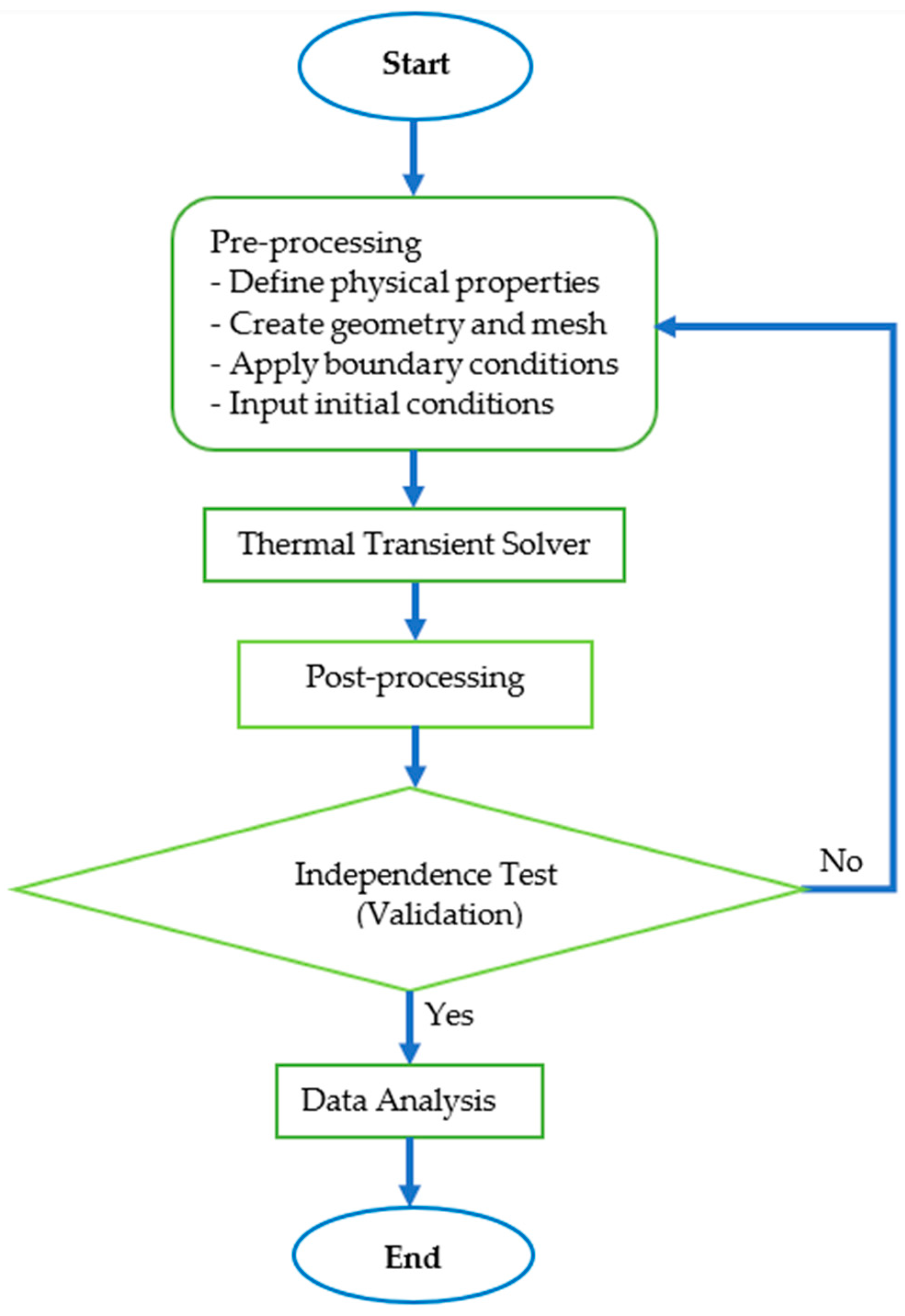

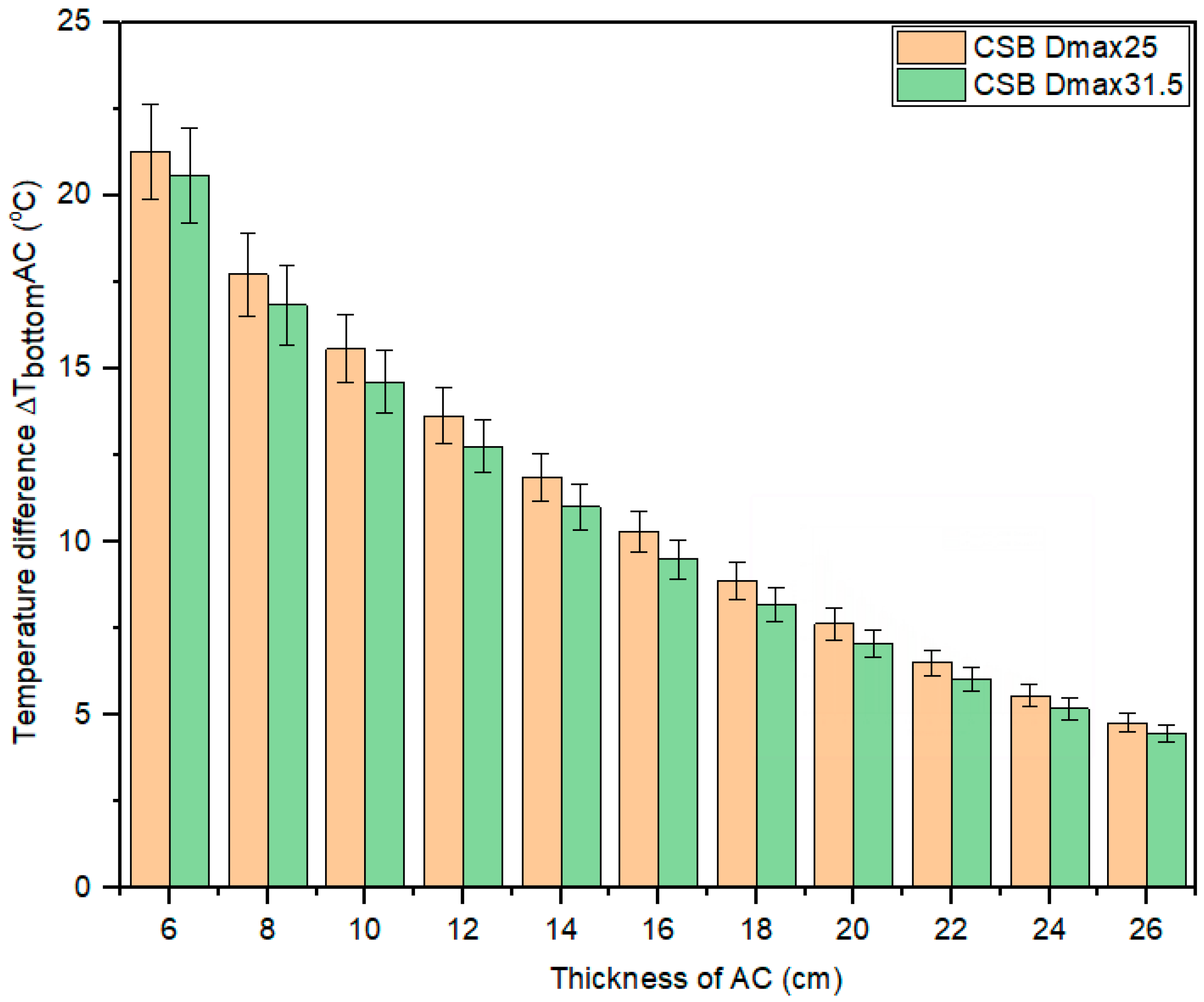




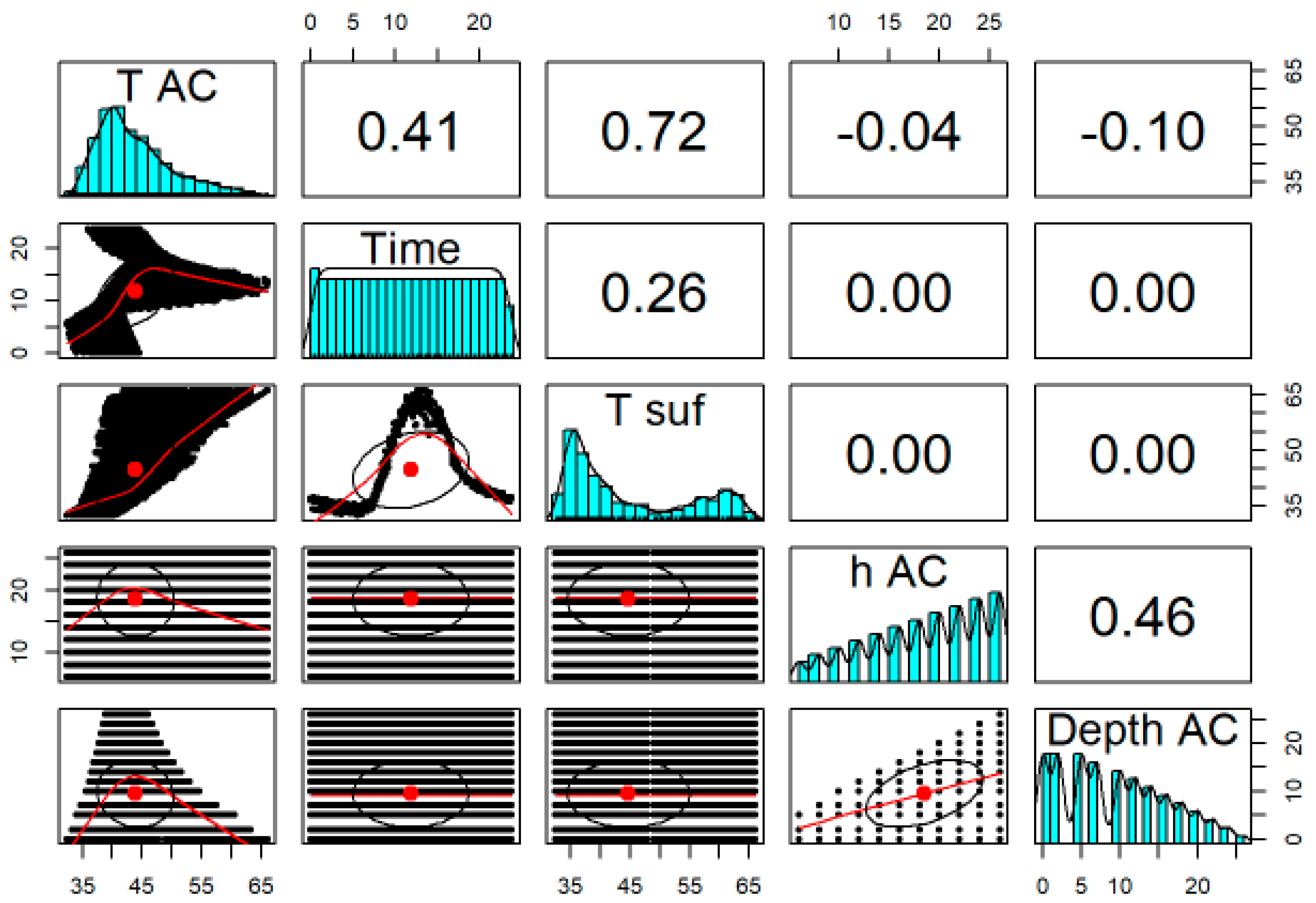
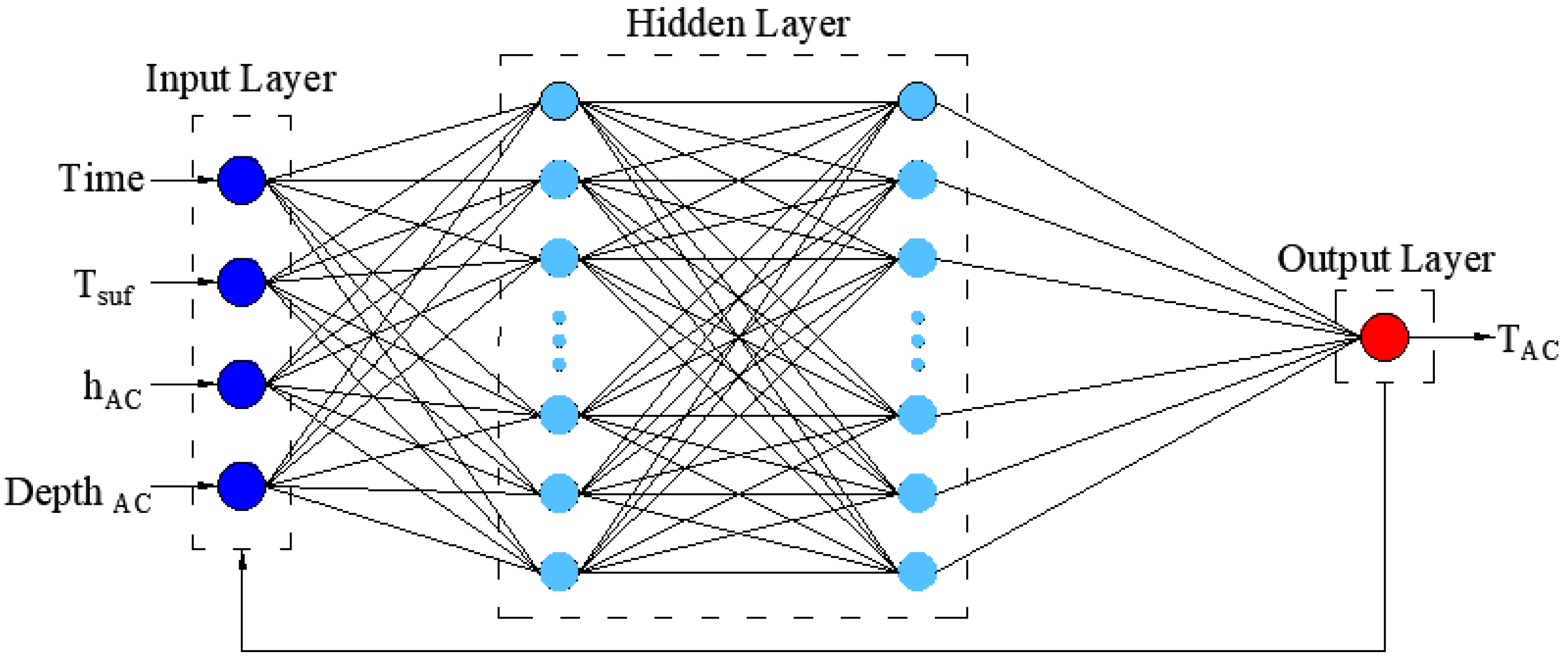
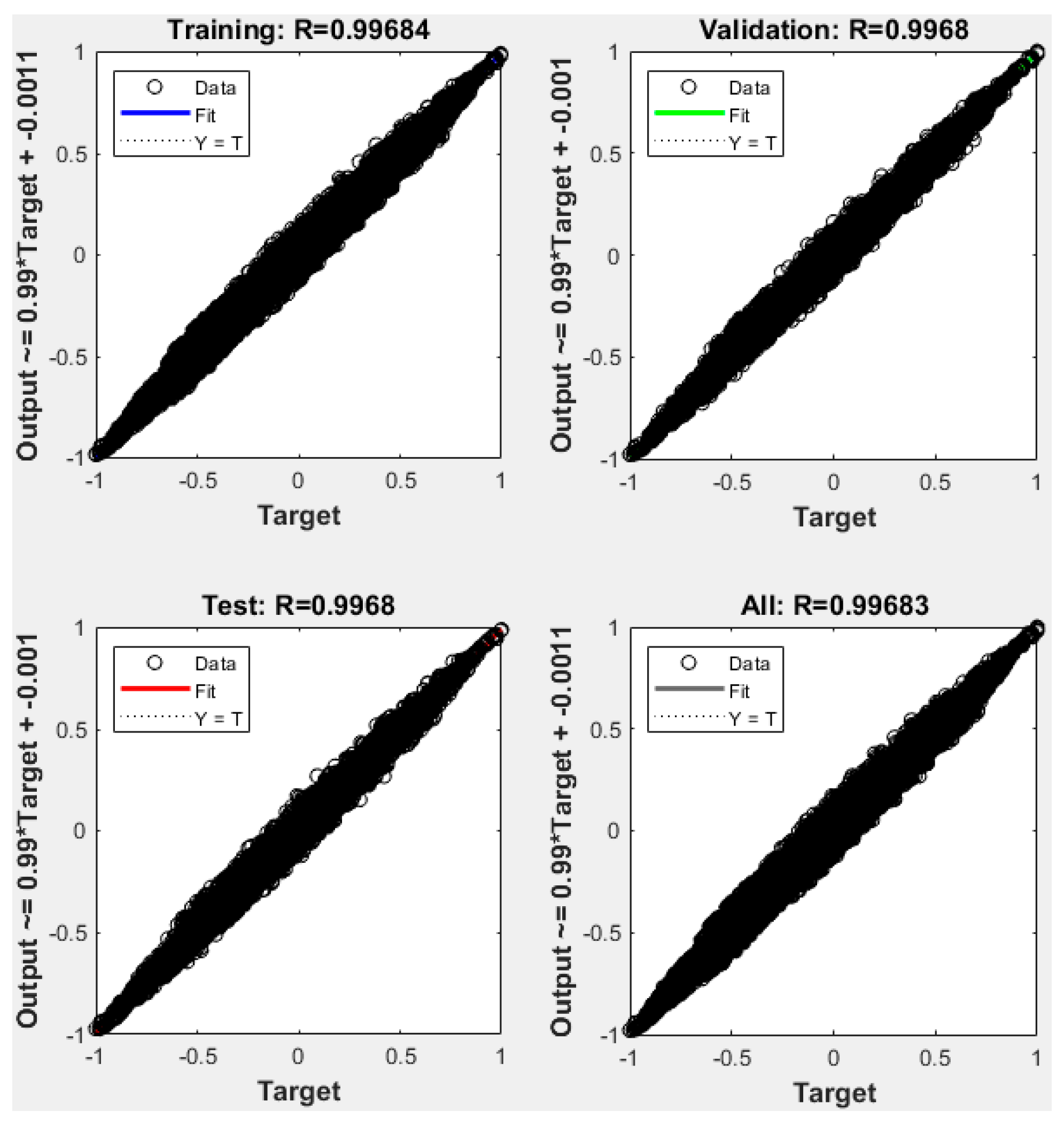


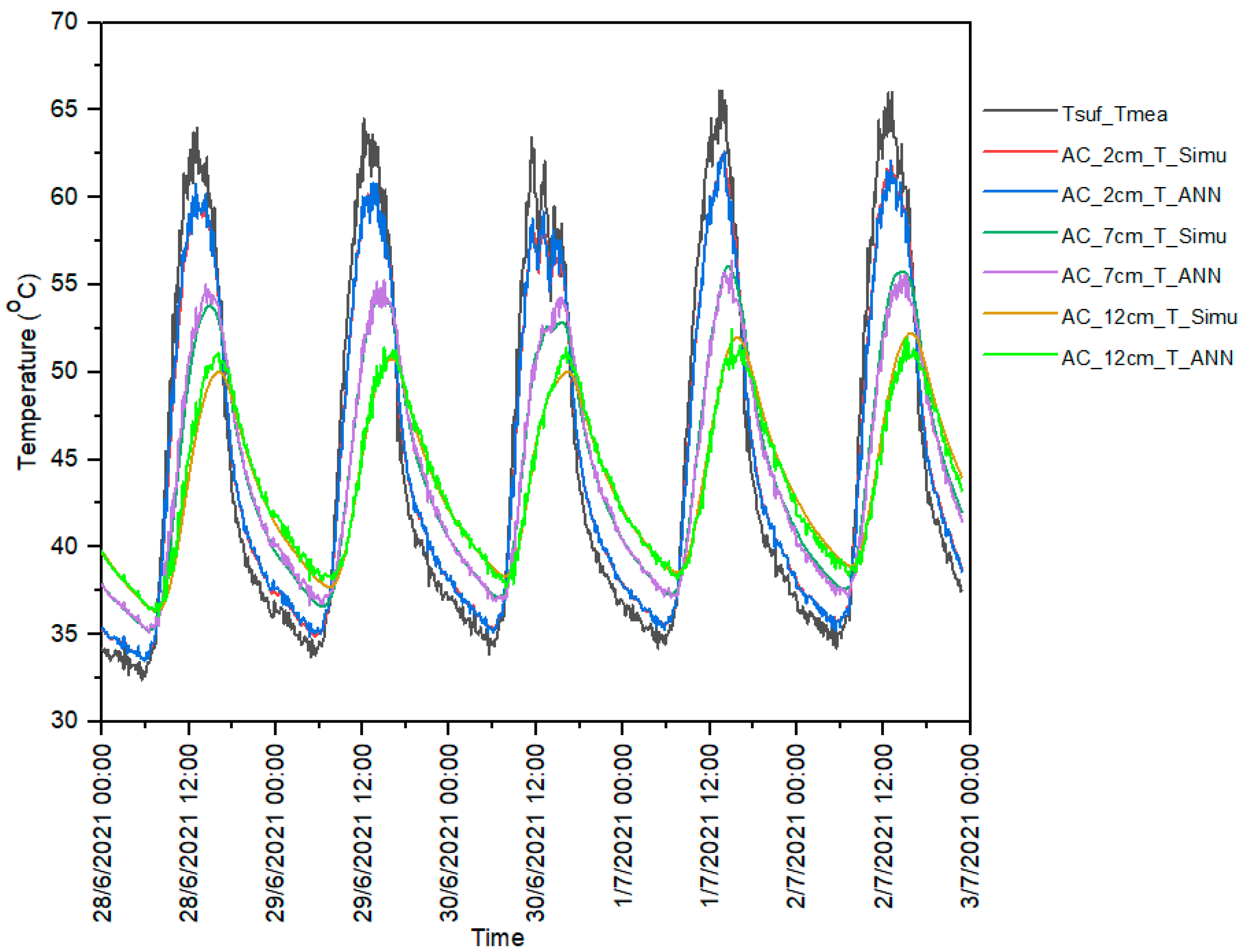
| Thermal Properties | Temperature of CSB (°C) | |||||
|---|---|---|---|---|---|---|
| 40 | 45 | 50 | 55 | 60 | ||
| CSB 0R | Thermal conductivity, λ (W·(m·°C)−1) | 0.899 | 1.023 | 1.146 | 1.270 | 1.393 |
| Specific heat capacity, C (J·(kg·°C)−1) | 1280.70 | 1330.59 | 1372.54 | 1408.31 | 1439.16 | |
| Density, ρ (kg·m−3) | 2265 | |||||
| CSB 5R | Thermal conductivity, λ (W·(m·°C)−1) | 1.442 | 1.342 | 1.242 | 1.142 | 1.042 |
| Specific heat capacity, C (J·(kg·°C)−1) | 2032.26 | 1726.46 | 1469.70 | 1251.07 | 1062.65 | |
| Density, ρ (kg·m−3) | 2294 | |||||
| CSB 10R | Thermal conductivity, λ (W·(m·°C)−1) | 1.113 | 1.049 | 0.985 | 0.921 | 0.857 |
| Specific heat capacity, C (J.(kg.°C)−1) | 1780.24 | 1493.33 | 1263.27 | 1074.68 | 917.28 | |
| Density, ρ (kg·m−3) | 2184 | |||||
| CSB 20R | Thermal conductivity, λ (W·(m·°C)−1) | 1.003 | 0.930 | 0.856 | 0.783 | 0.709 |
| Specific heat capacity, C (J·(kg·°C)−1) | 1748.54 | 1424.53 | 1170.41 | 965.78 | 797.46 | |
| Density, ρ (kg·m−3) | 2174 | |||||
| Paving Materials | Density, ρ (kg·m−3) | Temperature of Materials (°C) | Thermal Conductivity, λ (W·(m·°C)−1) | Specific Heat Capacity, C (J·(kg·°C)−1) |
|---|---|---|---|---|
| AC [10] | 2387 | 30 | 1.59 | 1068.6 |
| 2387 | 35 | 1.65 | 1087.8 | |
| 2387 | 40 | 1.71 | 1106.2 | |
| 2387 | 45 | 1.77 | 1124.0 | |
| 2387 | 50 | 1.83 | 1141.1 | |
| 2387 | 55 | 1.89 | 1157.6 | |
| 2387 | 60 | 1.95 | 1173.5 | |
| 2387 | 65 | 2.01 | 1188.9 | |
| 2387 | 70 | 2.07 | 1203.7 | |
| CSB Dmax 31.5 [10] | 2371 | 30 | 1.44 | 1063.4 |
| 2371 | 35 | 1.48 | 1063.9 | |
| 2371 | 40 | 1.53 | 1064.4 | |
| 2371 | 45 | 1.58 | 1064.9 | |
| 2371 | 50 | 1.62 | 1065.3 | |
| 2371 | 55 | 1.67 | 1065.7 | |
| 2371 | 60 | 1.72 | 1066.1 | |
| Aggregate subbase [42] | 2187 | 1.8 | 964 | |
| Soil subgrade [42] | 1418 | 1.1 | 840 |
| AC thickness (cm) | 6 | 8 | 10 | 12 | 14 | 16 | 18 | 20 | 22 | 24 | 26 |
| ΔTbottomAC change (%) | 3.3 | 5.2 | 6.5 | 6.9 | 7.9 | 8.3 | 8.5 | 8.1 | 7.9 | 7.4 | 7.3 |
| ΔTmaxAC change (%) | −5.5 | −4.1 | −3.8 | −1.9 | −1.9 | −1.4 | −1.0 | −0.5 | −0.9 | −0.6 | −0.2 |
| AC Thickness (cm) | 6 | 8 | 10 | 12 | 14 | 16 | 18 | 20 | 22 | 24 | 26 | |
|---|---|---|---|---|---|---|---|---|---|---|---|---|
| ΔTbottomAC change (%) | 5R | −7.0 | −11.6 | −14.2 | −16.4 | −18.0 | −19.1 | −19.9 | −20.4 | −20.0 | −20.2 | −20.4 |
| 10R | −0.5 | −1.8 | −3.1 | −4.2 | −5.2 | −6.1 | −6.7 | −7.2 | −6.9 | −7.2 | −7.5 | |
| 20R | 1.9 | 1.5 | 0.6 | −0.3 | −1.3 | −2.1 | −2.8 | −3.3 | −3.1 | −3.5 | −3.8 | |
| ΔTmaxAC change (%) | 5R | 9.5 | 7.8 | 5.4 | 3.2 | 1.6 | 0.8 | 0.3 | 0.2 | 0.0 | −0.2 | −0.3 |
| 10R | 2.4 | 3.0 | 2.4 | 1.6 | 0.9 | 0.4 | 0.2 | 0.1 | 0.0 | −0.1 | −0.2 | |
| 20R | −0.4 | 1.0 | 1.3 | 1.1 | 0.7 | 0.3 | 0.2 | 0.0 | 0.0 | −0.1 | −0.2 | |
| AC Depth (cm) | RMSE of AC Temperature (°C) between Numerical Simulation and ANN for Each AC Layer Thickness (cm) | ||||||||||
|---|---|---|---|---|---|---|---|---|---|---|---|
| 6 | 8 | 10 | 12 | 14 | 16 | 18 | 20 | 22 | 24 | 26 | |
| 0 | 0.35 | 0.33 | 0.33 | 0.33 | 0.33 | 0.33 | 0.33 | 0.33 | 0.33 | 0.34 | 0.34 |
| 2 | 0.30 | 0.29 | 0.28 | 0.28 | 0.28 | 0.28 | 0.28 | 0.28 | 0.28 | 0.39 | 0.38 |
| 5 | 0.35 | 0.34 | 0.34 | 0.34 | 0.33 | 0.33 | 0.33 | 0.33 | 0.33 | 0.33 | 0.33 |
| 7 | - | 0.39 | 0.37 | 0.36 | 0.36 | 0.36 | 0.36 | 0.35 | 0.35 | 0.34 | 0.34 |
| 10 | - | - | 0.42 | 0.41 | 0.40 | 0.40 | 0.40 | 0.39 | 0.38 | 0.37 | 0.37 |
| 12 | - | - | - | 0.44 | 0.43 | 0.43 | 0.42 | 0.41 | 0.40 | 0.39 | 0.39 |
| 14 | - | - | - | - | 0.46 | 0.46 | 0.45 | 0.44 | 0.42 | 0.41 | 0.41 |
| 16 | - | - | - | - | - | 0.48 | 0.47 | 0.46 | 0.44 | 0.43 | 0.67 |
| 18 | - | - | - | - | - | - | 0.49 | 0.48 | 0.46 | 0.44 | 0.44 |
| 20 | - | - | - | - | - | - | - | 0.50 | 0.48 | 0.46 | 0.45 |
| 22 | - | - | - | - | - | - | - | - | 0.50 | 0.47 | 0.47 |
| 24 | - | - | - | - | - | - | - | - | - | 0.49 | 0.48 |
| 26 | - | - | - | - | - | - | - | - | - | - | 0.50 |
Disclaimer/Publisher’s Note: The statements, opinions and data contained in all publications are solely those of the individual author(s) and contributor(s) and not of MDPI and/or the editor(s). MDPI and/or the editor(s) disclaim responsibility for any injury to people or property resulting from any ideas, methods, instructions or products referred to in the content. |
© 2024 by the authors. Licensee MDPI, Basel, Switzerland. This article is an open access article distributed under the terms and conditions of the Creative Commons Attribution (CC BY) license (https://creativecommons.org/licenses/by/4.0/).
Share and Cite
Tran, T.T.T.; Pham, P.N.; Nguyen, H.H.; Nguyen, P.Q.; Zhuge, Y.; Liu, Y. Temperature Distribution in Asphalt Concrete Layers: Impact of Thickness and Cement-Treated Bases with Different Aggregate Sizes and Crumb Rubber. Buildings 2024, 14, 2470. https://doi.org/10.3390/buildings14082470
Tran TTT, Pham PN, Nguyen HH, Nguyen PQ, Zhuge Y, Liu Y. Temperature Distribution in Asphalt Concrete Layers: Impact of Thickness and Cement-Treated Bases with Different Aggregate Sizes and Crumb Rubber. Buildings. 2024; 14(8):2470. https://doi.org/10.3390/buildings14082470
Chicago/Turabian StyleTran, Thao T. T., Phuong N. Pham, Hai H. Nguyen, Phuc Q. Nguyen, Yan Zhuge, and Yue Liu. 2024. "Temperature Distribution in Asphalt Concrete Layers: Impact of Thickness and Cement-Treated Bases with Different Aggregate Sizes and Crumb Rubber" Buildings 14, no. 8: 2470. https://doi.org/10.3390/buildings14082470






